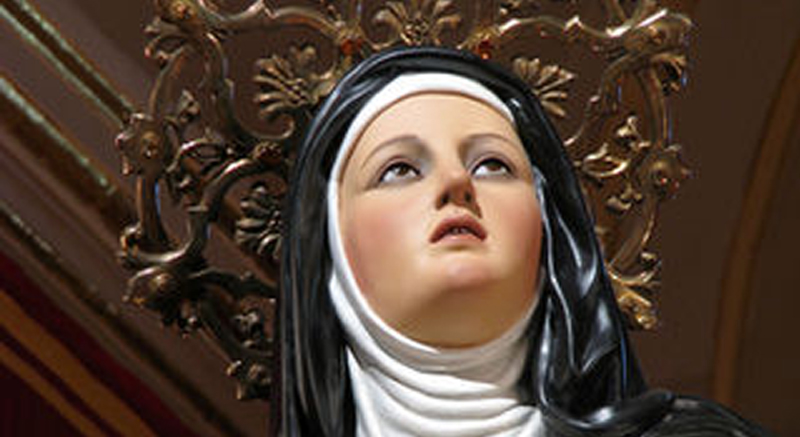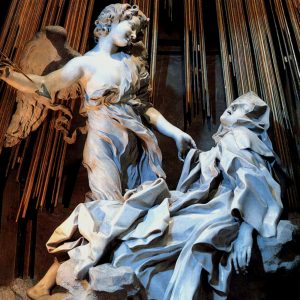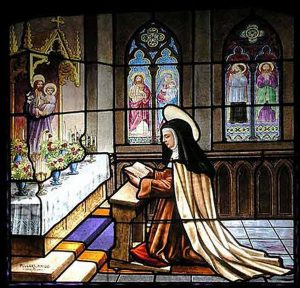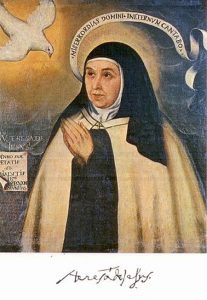Teresa of Ávila, born Teresa Sánchez de Cepeda y Ahumada, is called St. Teresa of Jesus.
She was born March 28, 1515, and died on Oct. 1582.
She was a Spanish noblewoman who felt called to convent life in the Catholic Church. A Carmelite nun, prominent Spanish mystic, religious reformer, author, theologian of the contemplative life and of mental prayer, she earned the rare distinction of being declared a Doctor of the Church, but not until after four centuries after her death.
Active during the Catholic Reformation, she reformed the Carmelite Orders of women and men. The movement she initiated was later joined by the younger Spanish Carmelite friar and mystic John of the Cross. It led eventually to the establishment of the Discalced Carmelites. A formal papal decree adopting the split from the old order was issued in 1580.
Teresa, who had been a social celebrity in her home province, was dogged by early family losses and ill health. In her mature years, she became the central figure of a movement of spiritual and monastic renewal borne out of an inner conviction and honed by ascetic practice. She was also at the center of deep ecclesiastical controversy as she took on the pervasive laxity in her order against the background of the Protestant reformation sweeping over Europe and the Spanish Inquisition asserting church discipline in her home country.
The consequences were to last well beyond her life. One papal legate described her as a “restless wanderer, disobedient, and stubborn femina who, under the title of devotion, invented bad doctrines, moving outside the cloister against the rules of the Council of Trent and her prelates; teaching as a master against Saint Paul’s orders that women should not teach.
Her written contributions, which include her autobiography, “The Life of Teresa of Jesus,” and her seminal work The Interior Castle, are today an integral part of Spanish Renaissance literature. Together with The Way of Perfection, her works form part of the literary canon of Christian mysticism and Christian meditation practice, and continue to attract interest from people both within and outside the Catholic Church.
Other associations with Teresa beyond her writings continue to exert a wide influence. A Santero image of the Immaculate Conception of El Viejo, said to have been sent by her with a brother emigrating to Peru, was canonically crowned by Pope John Paul II on Dece. 28, 1989, at the Shrine of El Viejo in Nicaragua. Another Catholic tradition holds that St. Teresa is personally associated with devotion to the Infant Jesus of Prague, a statue she may have owned.
Since her death, her reputation has grown, leading to multiple portrayals. She continues to be widely noted as an inspiration to philosophers, theologians, historians, neurologists, fiction writers and artists, as well as to countless ordinary people interested in Christian spirituality and mysticism.
Forty years after her death in 1622, Teresa was canonized by Pope Gregory XV. At the time she was considered a candidate for national patron saint of Spain, but this designation was awarded to St. James the Apostle. She has since become one of the patron saints of Spain. On Sept. 27, 1970, Pope Paul VI proclaimed Teresa the first female Doctor of the Church in recognition of her centuries-long spiritual legacy to Catholicism.
Early life
Teresa Sánchez de Cepeda y Ahumada was born in 1515 in Ávila, Spain. Her paternal grandfather, Juan Sánchez de Toledo, was a marrano or Converso, a Jew forced to convert to Christianity or emigrate.
When Teresa’s father was a child, Juan (her grandfather) was condemned by the Spanish Inquisition for allegedly returning to the Jewish faith, but he was later able to assume a Catholic identity. Her father, Alonso Sánchez de Cepeda, was a successful wool merchant and one of the wealthiest men in Ávila. He bought a knighthood and assimilated successfully into Christian society.
Previously married to Catalina del Peso y Henao, with whom he had three children, in 1509, Sánchez de Cepeda married Teresa’s mother, Beatriz de Ahumada y Cuevas, in Gotarrendura.
Teresa’s mother brought her up as a dedicated Christian. Fascinated by accounts of the lives of the saints, she ran away from home at age 7, with her brother Rodrigo, to seek martyrdom in the fight against the Moors. Her uncle brought them home, when he spotted them just outside the town walls.
When Teresa was 11, her mother died, leaving her grief-stricken. This prompted her to embrace a deeper devotion to the Virgin Mary as her spiritual mother. Teresa was also enamored of popular fiction, which at the time consisted primarily of medieval tales of knighthood and works about fashion, gardens and flowers. Teresa was sent to the Augustinian nuns’ school at Ávila.
Entry into religious life
After completing her education, she initially resisted the idea of a religious vocation, but after a stay with her uncle and other relatives, she relented. In 1536, at age 20, much to the disappointment of her pious and austere father, she decided to enter the local easy-going Carmelite Convent of the Incarnation, significantly built on top of land that had been used previously as a burial ground for Jews.
She took up religious reading on contemplative prayer, especially Osuna’s Third Spiritual Alphabet (1527). Her zeal for mortification caused her to become ill again and she spent almost a year in bed, causing huge worry to her community and family. She nearly died but she recovered, attributing her recovery to the miraculous intercession of St. Joseph. She began to experience instances of religious ecstasy.
Foundations of spirituality
Her reading of medieval mystics, consisted of directions for examinations of conscience and for spiritual self-concentration and inner contemplation known in mystical nomenclature as oratio recollectionis or oratio mentalis. She also dipped into other mystical ascetic works and perhaps some upon which Ignatius of Loyola based his Spiritual Exercises—possibly the Spiritual Exercises themselves.
She reported that, during her illness, she had risen from the lowest stage, “recollection,” to the “devotions of silence” or even to the “devotions of ecstasy,” which was one of perfect union with God. During this final stage, she said she frequently experienced a rich “blessing of tears.”
As the Catholic distinction between mortal and venial sin became clear to her, she came to understand the awful terror of sin and the inherent nature of original sin. She also became conscious of her own natural impotence in confronting sin and the necessity of absolute subjection to God.
Around the same time, she received a copy of the full Spanish translation of St. Augustine’s autobiographical work Confessions. The text helped her realize that holiness was indeed possible and she found solace in how such a great saint was once a sinner. In her Autobiography, she wrote that she ‘was very fond of St. Augustine…for he was a sinner too.’
Theresa’s visions
At about 1556, friends suggested that her newfound knowledge was diabolical, not divine. She had begun to inflict mortifications of the flesh upon herself. But her confessor, the Jesuit Francis Borgia, reassured her of the divine inspiration of her thoughts.
On St. Peter’s Day in 1559, Teresa became firmly convinced that Jesus Christ presented Himself to her in bodily form, though invisible. These visions lasted almost uninterrupted for more than two years. In another vision, a seraph drove the fiery point of a golden lance repeatedly through her heart, causing an ineffable spiritual and bodily pain:
“I saw in his hand a long spear of gold, and at the point there seemed to be a little fire. He appeared to me to be thrusting it at times into my heart, and to pierce my very entrails; when he drew it out, he seemed to draw them out also, and to leave me all on fire with a great love of God. The pain was so great, that it made me moan; and yet so surpassing was the sweetness of this excessive pain, that I could not wish to be rid of it.”
This vision was the inspiration for one of Bernini’s most famous works, the Ecstasy of Saint Teresa at Santa Maria della Vittoria in Rome.
The memory of this episode served as an inspiration throughout the rest of her life, and motivated her lifelong imitation of the life and suffering of Jesus, epitomized in the adage often associated with her: “Lord, either let me suffer or let me die.”
Embarrassment of raptures
Teresa, who became a celebrity in her town dispensing wisdom from behind the convent grille, was also known for her raptures, which sometimes involved levitation. It was a source of embarrassment to her and she bade her sisters hold her down when this occurred. Subsequently, historians, neurologists and psychiatrists such as Peter Fenwick and Javier Alvarez-Rodriguez, among others, have taken an interest in her symptomatology. The fact that she wrote down virtually everything that happened to her during her religious life means that an invaluable and exceedingly rare medical record from the 16th century has been preserved.
Monastic reformer
Over time, Teresa found herself increasingly at odds with the spiritual malaise prevailing in her convent of the Incarnation. Among the 150 nuns living there, the observance of cloister, designed to protect and strengthen spiritual practice and prayer, became so lax that it appeared to lose its purpose. The daily invasion of visitors, many of high social and political rank, disturbed the atmosphere with frivolous concerns and vacuous conversation. Such intrusions in the solitude essential to develop and sustain contemplative prayer so grieved Teresa that she longed to intervene.
The incentive to take the practical steps inspired by her inward motivation was supported by the Franciscan priest, Peter of Alcantara, who met her early in 1560 and became her spiritual adviser. She resolved to found a “reformed” Carmelite convent, correcting the laxity which she had found at the Incarnation convent and elsewhere besides. Guimara de Ulloa, a woman of wealth and a friend, supplied the funds for the project.
The abject poverty of the new convent, established in 1562 and named St. Joseph’s (San José), at first caused a scandal among the citizens and authorities of Ávila, and the small house with its chapel was in peril of suppression. However, powerful patrons, including the local bishop, coupled with the impression of well- ordered subsistence and purpose, turned animosity into approval.
In March 1563, after Teresa had moved to the new convent house; she received papal sanction for her primary principles of absolute poverty and renunciation of ownership of property, which she proceeded to formulate into a “constitution”. Her plan was the revival of the earlier, stricter monastic rules, supplemented by new regulations including the three disciplines of ceremonial flagellation prescribed for the Divine Office every week, and the discalceation of the religious. For the first five years, Teresa remained in seclusion, mostly engaged in prayer and writing.
Church window at the convent of St. Theresa
Extended travels
In 1567, Teresa received a patent from the Carmelite General to establish further houses of the new order. This process required many visitations and long journeys across nearly all the provinces of Spain. She left a record of the arduous project in her Libro de las Fundaciones. Between 1567 and 1571, reformed convents were established at Medina del Campo, Malagón, Valladolid, Toledo, Pastrana, Salamanca, and Alba de Tormes.
As part of the original patent, Teresa was given permission to set up two houses for men who wished to adopt the reforms. She convinced two Carmelite friars, John of the Cross and Father Anthony of Jesus to help with this. They founded the first monastery of Discalced Carmelite brothers in November 1568 at Duruelo. Another friend of Teresa, Jerónimo Gracián, the Carmelite visitator of the older observance of Andalusia and apostolic commissioner, and later provincial of the Teresian order, gave her powerful support in founding monasteries at Segovia (1571), Beas de Segura (1574), Seville (1575), and Caravaca de la Cruz (Murcia, 1576). Meanwhile, John of the Cross promoted the inner life of the movement through his power as a teacher and preacher.
Opposition to reforms
In 1576, unreformed members of the Carmelite order began to persecute Teresa, her supporters and her reforms. Following a number of resolutions adopted at the general chapter at Piacenza, the governing body of the order forbade all further founding of reformed convents. The general chapter instructed her to go into “voluntary” retirement at one of her institutions. She obeyed and chose St. Joseph’s at Toledo. Meanwhile, her friends and associates were subjected to further attacks.
Several years later, her appeals by letter to King Philip II of Spain secured relief. As a result, in 1579, the cases before the inquisition against her, Father Gracian and others, were dropped. This allowed the reform to resume. An edict from Pope Gregory XIII allowed the appointment of a special provincial for the newer branch of the Carmelite religious, and a royal decree created a “protective” board of four assessors for the reform.
During the last three years of her life, Teresa founded convents at Villanueva de la Jara in northern Andalusia (1580), Palencia (1580), Soria (1581), Burgos, and Granada (1582). In total, seventeen convents, all but one founded by her, and as many men’s monasteries, were owed to her reforms over a period of twenty years.
Last days
Her final illness overtook her on one of her journeys from Burgos to Alba de Tormes. She died in 1582, just as Catholic Europe was making the switch from the Julian to the Gregorian calendar. According to the liturgical calendar then in use, she died on the 15th in any case. Her last words were: “My Lord, it is time to move on. Well then, may your will be done. O my Lord and my Spouse, the hour that I have longed for has come. It is time to meet one another.”
Holy relics
She was buried at the Convento de la Anunciación in Alba de Tormes. Nine months after her death the coffin was opened and her body was found to be intact but the clothing had rotted. Before the body was re-interred one of her hands was cut off, wrapped in a scarf and sent to Ávila. Father Gracián cut the little finger off the hand and — according to his own account — kept it with him until it was taken by the occupying Ottoman Turks, from whom he had to redeem it with a few rings and 20 reales. The body was exhumed again on Nov. 25, 1585, to be moved to Ávila and found to be incorrupt. An arm was removed and left in Alba de Tormes at the nuns’ request, to compensate for losing the main relic of Teresa, but the rest of the body was reburied in the Discalced Carmelite chapter house in Ávila.
The removal was done without the approval of the Duke of Alba de Tormes and he brought the body back in 1586, with Pope Sixtus V ordering that it remain in Alba de Tormes on pain of excommunication. A grander tomb on the original site was raised in 1598 and the body was moved to a new chapel in 1616.
In 1622, 40 years after her death, she was canonized by Pope Gregory XV. The Cortes exalted her to patroness of Spain in 1627. The University of Salamanca had granted her the title Doctor ecclesiae (Latin for “Doctor of the Church”) with a diploma in her lifetime but that title is distinct from the papal honor of Doctor of the Church, which is always conferred posthumously. The latter was finally bestowed upon her by Pope Paul VI on September 27, 1970, along with Saint Catherine of Siena, making them the first women to be awarded the distinction. Teresa is revered as the Doctor of Prayer. The mysticism in her works exerted a formative influence upon many theologians of the following centuries, such as Francis of Sales, Fénelon and the Port-Royalists. In 1670, her coffin was plated in silver.
Mysticism
The ultimate preoccupation of Teresa’s mystical thought, as consistently reflected in her writings, is the ascent of the soul to God in four stages: Devotion of the Heart. Devotion of Peace, Devotion of Union and Devotion of Ectasy.
Teresa is regarded as one of the foremost writers on mental prayer, and her position among writers on mystical theology as unique. Her writings on this theme, stem from her personal experiences, thereby manifesting considerable insight and analytical gifts.
Her definitions have been used in the Catechism of the Catholic Church. Teresa states: “Contemplative prayer (oración mental), in my opinion is nothing other than a close sharing between friends. It means frequently taking time to be alone with Him whom we know loves us.” Throughout her writings, Teresa returns to the image of watering one’s garden as a metaphor for mystical prayer.
Writings
This is the one portrait of Teresa that is probably the most true to her
appearance. It is a copy of an original 1576 painting of her when she was 61.
Teresa’s writings are regarded as among the most remarkable in the mystical literature of the Catholic Church. They include:
-
The Autobiography, written before 1567.
-
El Camino de Perfección (The Way of Perfection), written also before 1567.
-
“Meditations on Song of Songs”, 1567, written nominally for her daughters at the convent of Our Lady of Mount Carmel.
-
El Castillo Interior (The Interior Castle), 1577.
-
Relaciones (Relationships)
-
Two smaller works are the Conceptos del Amor (“Concepts of Love”) and Exclamaciones
-
St Teresa’s prose is marked by an unaffected grace, an ornate neatness, and charming power of expression, together placing her in the front rank of Spanish prose writers. The first edition of Teresa’s letters was published in 1658 with the comment of Juan de Palafox y Mendoza, Roman Catholic bishop of Osma and an opponent to the Company of Jesus.
-
Her rare poems (“Todas las poesías”, Munster, 1854) are distinguished for tenderness of feeling and rhythm of thought.
Philosophical works
Christia Mercer, Columbia University philosophy professor, claims that the seventeenth-century Frenchman René Descartes lifted some of his most influential ideas from Teresa of Ávila, who, fifty years before Descartes, wrote popular books about the role of philosophical reflection in intellectual growth. She describes a number of striking similarities between Descartes’ seminal work Meditations on First Philosophy and Teresa’s Interior Castle.
Excerpts
Teresa, who reported visions of Jesus and Mary, was a strong believer in the efficacy of holy water, claiming to have used it with success to repel evil spirits and temptations. She wrote: “I know from frequent experience that there is nothing which puts devils to flight better than holy water.”
A poem
Let nothing disturb you.
Let nothing make you afraid.
All things are passing.
God alone never changes.
Patience gains all things.
If you have God you will want for nothing.
God alone suffices.
— St. Teresa, The bookmark of Teresa of Ávila,
St Theresa (Francois Gerard, 1827)




